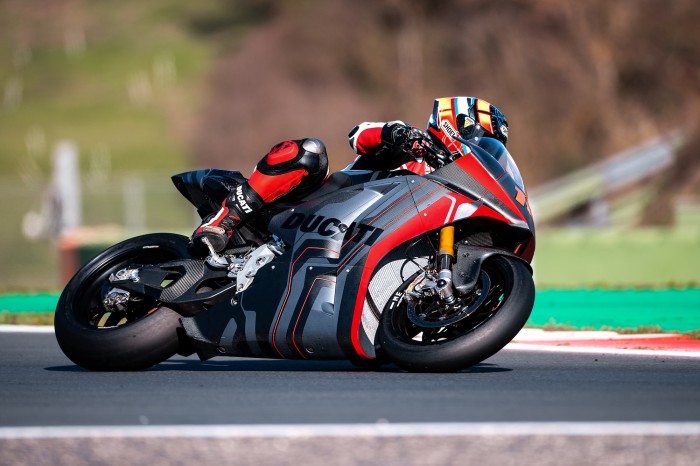Ducati has released details of its MotoE project ahead of the Bologna brand’s takeover of the FIM World Cup from 2023.
Set to replace Energica as sole supplier from next season with the roll out of 18 electric class machines, the "V21L" prototype has been a close collaboration between the R&D department of Ducati and Ducati Corse with support from riders Michele Pirro, Alex De Angelis and Chaz Davies as part of the Ducati Corse test team led by Marco Palmerini.
"A few weeks ago I had the extraordinary opportunity to ride the Ducati MotoE on the track and I immediately realised that I was living in a historic moment,” Ducati CEO, Claudio Domenicali commented. "The world is going through a complex period and environmental sustainability is an element that all individuals and all companies must consider a priority if we want to preserve the delicate balance of the planet.
“As Ducati, we have grasped this need and we went in search of a challenge that would allow us to contribute to the common goal of reducing CO₂ emissions and at the same time to keep faith with our DNA linked to racing.
“We agreed with determination to develop the most performing electric racing bike that current technology makes possible and to use this project as a laboratory in which to build our future. The result we have achieved is surprising.
“As soon as I sat on the bike I realised the quality of the work done by the team and when I returned to the garage I felt a deep sense of pride for what we were once again able to achieve."
The Ducati MotoE has a total weight of 225 kg (12 kg less than the minimum requirements imposed by Dorna and FIM for a bike capable of completing the race distance) and can count on maximum power and torque figures of 110 kW (150 hp) and 140 Nm respectively, which allows it to reach a speed of 275 km/h on a circuit like Mugello.
The battery pack weighs 110 kg and offers a capacity of 18 kWh with a 20-kW charging socket integrated into the tail. Inside there are 1,152 cylindrical cells of the "21700" type.
The inverter, with a low weight of 5 kg, is a unit derived from a high-performance model used in four wheel electric racing, while the motor (21 kg weight and a maximum rotation speed of 18,000 rpm) was developed by a partner following the technical specifications provided by Ducati. The entire system is based on a voltage of 800V (with a fully charged battery pack) to maximise the output of the electric powertrain and, as a consequence, performance and range.
One of the most advanced technical solutions tested on the Ducati MotoE concerns the cooling system. A sophisticated and efficient liquid system with a double circuit designed to meet the different thermal needs of the battery pack and the motor/inverter unit. This guarantees extreme regularity of temperatures with important benefits in terms of consistency of performance but also in charging times.
The Ducati MotoE can be charged as soon as it enters the garage, and takes about 45 minutes to recharge up to 80% of its range.
The carbon fibre battery case also acts as a stressed part of the chassis, attempting to replicate the Ducati Panigale V4 engine, with an aluminium monocoque frame for the front area weighing 3.7 kg. The rear is composed of an aluminium swingarm weighing 4.8 kg with a geometry like that of the Ducati Desmosedici MotoGP. The rear subframe, which integrates the tail and the rider seat, is made of carbon fibre.
The suspension area features an Öhlins NPX 25/30 pressurised fork with 43 mm diameter upside-down tubes at the front, derived from the Superleggera V4, while an Öhlins TTX36 shock absorber is present at the rear and is fully adjustable. The steering damper is an adjustable Öhlins unit.
The Brembo braking system is composed of a 338.5mm diameter increased thickness double steel disc at the front. Fins on the internal diameter aim to increase the thermal exchange surface area and improve disc cooling in conditions of extreme use on the track. Two GP4RR M4 32/36 calipers with a PR19/18 radial master cylinder operate on this double disc. At the rear, the P34 caliper acts on a single disc unit 220 mm in diameter and 5 mm thick with a PS13 master cylinder. Teams can also choose to equip their bikes with an optional rear brake control positioned on the left handlebar, which the rider can use as an alternative to the pedal one.
Through the work on the electronics, the aim was to obtain a throttle response like that of an endothermic unit and a response from the electronic controls (such as Ducati Traction Control, Ducati Slide Control, Ducati Wheelie Control and throttle/engine brake maps) indistinguishable from that of the racing bikes that Ducati riders are used to.










